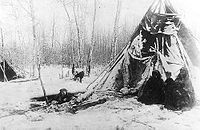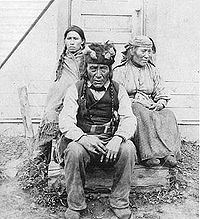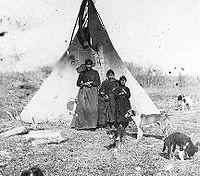- Danezaa people
-
File:Unidentified Dane-zaa circa 1911.jpgAn unidentified Dane-zaa, in the Peace River country, 1911
The Dane-zaa (ᑕᓀᖚ, also spelled Dunneza, or Tsattine, and historically often referred to as the Beaver tribe by Europeans) are a First Nation of the Athapaskan language group, whose traditional territory is around the Peace River of the provinces of Alberta and British Columbia, Canada. About 1,000 Dane-zaa are living today in British Columbia and perhaps half speak the Danezaa language.
History
Prior to 1800 they inhabited lands further east, near the Athabaska River and Clearwater River, and north to Lake Athabaska as well as territory north of the upper Peace River. Recent archaeological evidence establishes that the area of Charlie Lake north of Fort St John has been continuously occupied for 10,500 years. In the 18th century, the Peace River area was opened to fur trading. The Cree, a powerful people to the east of the Dane-zaa, had become highly dependent on the European goods and the maintenance of a trade monopoly with Northwest company traders (the Northwest Company later amalgamated with the Hudson Bay Company). Alexander Mackenzie established Rocky Mountain Fort at the mouth of the Moberly River in 1794. A post journal of 1799-1800 mentions people trading into the post who can be identified as the ancestors of members of the former Fort St John Band, now the Doig and Blueberry First Nations. Oral history collected from elders at Doig confirms that the ancestors of present Dane-zaa families were in the upper Peace River area prior to first contact by Alexander Mackenzie in 1793. Traders provisioned their further expeditions with bison meat and grease from the rich prairies of the upper Peace River area. By the time the Hudson's Bay Company took over the Northwest Company in 1823, bison had become commercially extinct. For many years the Dane-zaa have followed the teachings and songs of their Dreamers, who first predicted the coming of the Europeans. The last Dreamer, Charlie Yahey, died in 1976. The Dane-zaa of Fort St John took an adhesion to Treaty 8 in 1900. Today they continue to have a vibrant cultural and economic presence in the North Peace area.
Danezaa First Nations
Treaty 8 Tribal Association[1]
- Doig River First Nation (Population: 249)
- Blueberry River First Nations (Danezaa and Cree, Population: 401)
- Halfway River First Nation (Population: 227)
- Prophet River First Nation (Population: 223)
- Saulteau First Nations (Saulteau, Danezaa, and Cree, Population: 840)
- West Moberly First Nations (Danezaa and Cree, Population: 193)
External links
- Doig River First Nation
- Map of Northwest Coast First Nations (including Dunneza)
- [http://www.gutenberg.org/ebooks/35659 Voyages from Montreal Through the Continent of North America to the Frozen and Pacific Oceans in 1789 and 1793 Vol. II (1903 ed.)
- Living In A Storied Land Royal British Columbia Museum
- The Dane-Zaa Living Landscape of Northeastern BC Royal British Columbia Museum
First Nations in Alberta Cultural areas Plains · SubarticNumbered Treaties Ethno-cultural groups and languages Beaver / Daneẕaa (language) · Blackfoot / Niitsítapi (language) · Chipewyan / Denésoliné (language) · Cree / Nēhilawē (Woodland Cree) (language [plains variant]) · Sarcee / Tsuu T'ina (language) · Saulteaux / Nakawē (language) · Stoney / Nakoda (language)
First Nation
governments (bands)Alexander · Alexis · Athabasca Chipewyan · Bearspaw · Beaver · Beaver Lake Cree · Bigstone Cree · Chiniki · Chipewyan Prairie · Cold Lake · Dene Tha' · Driftpile · Duncan's · Enoch Cree · Ermineskin Cree · Fort McKay · Fort McMurray · Frog Lake · Heart Lake · Horse Lake · Kainai · Kapawe'no · Kehewin Cree · Little Red River Cree · Loon River · Louis Bull · Lubicon Lake · Mikisew Cree · Montana · O'Chiese · Paul · Piikani · Saddle Lake · Samson Cree · Sawridge · Siksika · Smith's Landing · Sturgeon Lake · Sucker Creek · Sunchild · Swan River · Tallcree · Tsuu T'ina · Wesley · Whitefish Lake (Atikameg) · Whitefish Lake (Goodfish) · Woodland CreeCategories:
Wikimedia Foundation. 2010.



